by Nino Bugeja [Click Here For PDF Version]
Arguable, Charles Darwin was the first to explain how selection and evolution were the link to domestication. Darwin, through his book Natural Selection showed how human interaction and involvement led to his findings. Those findings were later to be viewed as a possible tool that indeed through the power of selection could and would change desired qualities in animal, seeds and grains. It would later be titled through human intervention Artificial Selection, and is recognized still today in the minds of many an animal breeder.
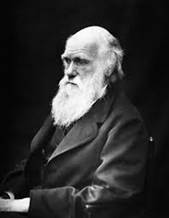
Presently today we can see the power of mans intervention with the use of selection as their tool of choice. The laying hen of today has the capability to produce 365 eggs a year, through generations of selection; milk production and meat weight gain of beef cattle all owe their separate outcomes to mans ability to apply and use selection as the driving force in their breeding program.
It must also be understood that along with selection, come another major part of all their successes and that is what is known as in-breeding and line-breeding. Without the merits of this type of breeding, none of this could be possible.
This type of breeding is an old one, and in some respects done without the knowledge of the breeder and unknowingly at the time was being practiced at the dawn of domestication by those farmers or keepers of animals that just had that great “animal sense” to create a better creature than the norm. They soon realized that if they only allowed those of better quality to mate and reproduce, their ideals would become one step closer to reality. Without them knowing, what they were practicing was a form of inbreeding/line-breeding along with selection and ultimately genetic purging, or commonly known as culling.
Artificial selection would prove to be the tool in the deciding difference between one animal and another. The reason why two full brothers, or sisters although of the same direct ancestral parentage, one would be allowed to breed and pass on its genetic information to its offspring, while the other would be culled. Through selection ones “Preference” and “Potential” of one from the other would be realized.
Charles’s Darwin was a Naturalist and the author of the book “Origin of Species” that refers to evolution and “Natural Selection’ with-in the environment.
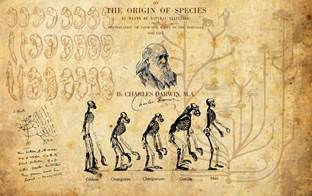
Thrown into this mix of discovery was another great man by the name of Gregory Mendel and he would become known as the discoverer of three basic laws of inheritance: the law of dominance, the law of segregation, and the third law was of independent assortment, all pertaining to chromosomes, genes and gene pairs, the blueprint of all living things. Mendel’s laws stated that inheritance was made possible by the passing of genes, and that these genes are present in pairs, one gene from each parent, and each new living creature would receive approximately 50% of each parent’s genetic make-up. The problem with this blueprint comes down to the of mix of genetics one had received in terms of their purity. For those of good animal sense, and vision they could see by following certain breeding practices, they were able to identify and shape its animal’s self worth. Man indeed could, and did become the creator of new and greater specimens.
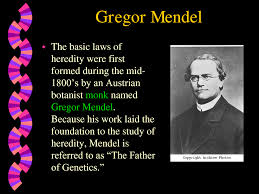
For the enthusiastic breeder he knows his desires are those that go beyond the mediocre specimen, he is constantly striving to achieve more purity in his stock for those characteristics ad traits he seeks. From this realization he knows the only way to stock of greater excellence, is to use stock that has greater purity than in name only. Our problem is in our ability to identify and separate these qualities we strive for within the population that makes up the breed itself.
Up to now, we have been discussing certain parameters on how things came to be what they are, and those that were first to make these discovery’s. Domestication in all its wonder played a role of separation in terms of what I call artificial creation which add up to Breeds with-in a Species of animal or birds For our discussion its pigeons, and to a finer point those know as Tipplers, a distinct breed of said pigeon.
Now you may ask, just what constitutes a Distinct Breed of pigeon, or any other domesticated animal I may add, well it simply has to do with genes, and a large number of them in common, so much that when they mate, their offspring are reproduced in a manner in which their characteristics and traits are expressed and passed on in future generation of offspring, therefore tying them together as a population that differentiates from other breeds of pigeon.. These are the parameters that constitute a Breed as we know it today.
Now that we have learned what makes up the term Breed among hobbyists of animal breeding brings us to another terminology, one that refers to a further distinct purification of gene pairs also known as Genetic Purity of the breed population itself, and that is the term Strain. Among animal enthusiasts, the term Strain really refers to stock of greater than normal purity of gene pairs of those desired characteristics we seek. For those of the animal circuit, the term “purebred” simply speaks to stock of the purest genetic purebreds.
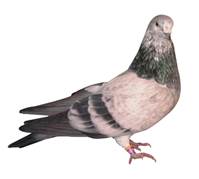
Having a better understanding of what a Breed represents, and a further more decisive understanding of the term Strain, one may ask himself how, and in what manner we get to this point. The first thing the aspiring breeder must grasp is to known what ones “Ideal” specimen is. It may also not be understood that every living creature in the natural world has an Ideal standard they have evolved to. We all have heard of the term, “only the strong survive” well this is very true in the natural world and thus a standard was born through natural selection of the environment they live in.
What differs in our case as breeders is the fact that man has created the Environment our stock shall live in, and thus the process of Natural Selection and survival of the fittest no longer plays a role in their well being, or creation of that ideal. We are in fact responsible for their existence, weather it be good or bad. We provide their food, water, minerals, and for that aspiring fancier I spoke about, the means in witch to control and direct that standard with-in the population.
Our new found breeder that aspires for excellence must now start to apply this knowledge in living creatures of his choice. He must never overlook Heredity, as it “refers to the distribution of racial characters among individuals of successive generations “only by knowing this can any breeding operation be successful and in this regard. It represents the essence of the generations passed down to your stock, and why they are what they appear to be, in performance or in phenotype.
The great animal breeders of the world new that when a certain trait was found with-in a certain mating, he must try and retain this feature that he seek-ed at all cost. The problem was how; well it was done through a closer mating of relatives than would be found in the natural population.
In animal circles the excepted definition of in-breeding (the closest form of mated relatives) relates to the mating of mother x son, father x daughter and brother and sister: line breeding relates to the mating of half brother x sister, uncle x niece, grandfather x granddaughter, grandmother x grandson, aunt x nephew and first cousins.
There are different methods of breeding, but most will attest that the most common one used is line-breeding, (a form of In-breeding.) The term itself implies one thing, and that is a certain “Line of Decent” in ones ancestry that relates to one individual that will be followed with strict restriction and selection of the mating of certain individuals. The unfortunate part in all of this is the lack of understanding by those fanciers that consider themselves worthy to the use of the term itself. When asked the obvious question, “line bred to what “they simply have no answer! This total lack of true understanding will surely be in part the reason their successes are few and far between.
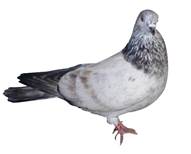
Experience has showed this approach has one purpose, and that is “Breed” improvement of all members that are among the line of decent. It not only combines stock in their Traits and Characteristics due to its restricted nature, but it also narrows the Pedigrees to fewer and more closely related family members, and by doing so exposes’ the very best line-breeding has to offer, or the worst.
The advantages lie in its predictability of their improvement at hand. All backed up by the most powerful hereditary influence that has been able to be obtained through the simplicity and strength of the ancestry, which, if the selection been correct, all pull together in one common direction.
Dr. Harlan Ritchie makes comment of one such line bred Hereford Bull below:
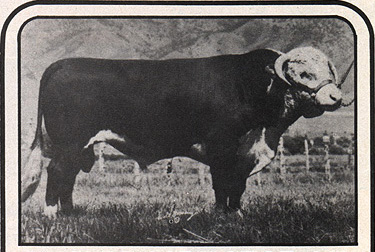
One of the great individuals produced from the line bred Prospectors was Prospector 7558. He was bred to over 110 of his own daughters without producing any genetic flaws. He is possibly the purest genetic package ever produced in the Hereford breed. The successes of the Michigan State herd, the Frank Felton herd and Witherspoons Nizhoni Herefords all trace in part to the influence and impact of this great sire. He was born in 1967, and was still being used 25 years later. We still have semen on this great sire and many of his descendents. Over half of the bulls in our 2000 Semen Sale Catalog are descendents of this great line bred sire.
Prospector 7558
Dr. Harlan Ritchie of Michigan State University had this to say about Prospector 7558: “We have used many of the top horned and polled Hereford bulls in our breeding program and, based on two years of natural service, we have found that Prospector 7558 sired more merchantable bulls and excellent replacement females than any other bull we have ever used. 7558 added frame size and muscle composition while also strengthening maternal traits as his daughters are standout females and exceptional milkers. The fact that he is 42% inbred makes him genetically very predictable which he has proven through his progeny. Prospector 7558 may have more superior performance genes without evidence of defect than any other known bull.”
Here again is proof of the power of close breeding. As noted below, Kojack has been a sire of exceptional Genetic Purity, producing dairy goats with exceptional utters and milk production.
| Kojack has been a consistent and impressive sire at Redwood Hills Farm. One of his daughters, GCH Satyr Kojack Trevi 7*M EX-93, was named the 2012 National Champion. He is the product of a breeding that was repeated several times, each producing beautiful daughters and exceptional sires. Kojack is very line bred, as Jacob and Wolfman Jack are full brothers. |
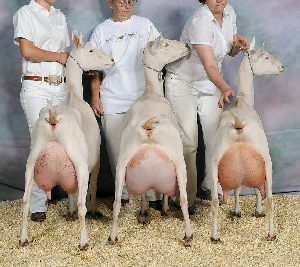
Breeding the Sire to his Daughter, (In-breeding) will give offspring that are three fourths of the genetic make-up of the Sire, and if this practice is carried forth, it will give rise to but one line of ancestry, and at the same time almost entirely eliminating that of the Dam. The same outcome would be experienced if the Dam was mated to her sons consecutively this is in affect, Line-Breeding carried to its limits, witch carry both advantages and disadvantages carried from their genetic make-up.
Breeding brother to sister will preserve their genetics representation in “Equal” proportions of both Sire and Dam. This form of breeding is inferior to the others as a means of strengthening previously existing genetics, but is used when the Combination has proved exceptional, and one wishes to continue the same.
All the above fall under the “Laws of Inheritance” and when done well, will take “possibility’s” to “predictability’s” that can raise ones stock to a new level of excellence.
For the informed breeder, he soon recognized that the road to further excellence was through the narrowing of traits and characteristics that exist in his population, and once found he would discard the mediocre and poor breeding specimens, in fact stop the flow of all poor genetics through culling. The fear of close breeding and selection had come of age to the informed breeder.
With this new found understanding of the power of genetic purity, came the means to his ideal specimen. . What was once shunned at, close mating of relatives was now the doorway of improvement and shown to be of greatest importance in terms of excellence. When an even closer mating of relatives was used (in-breeding) even greater purity would result, and further excellence would show its face.
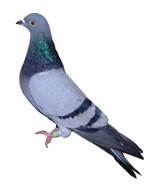
E. Davenport was among those early breeders that favored in-breeding, but only when done with sound selection. / He wrote in his book “Principles of Breeding”,
“Anyone who will take the trouble to study the pedigrees of famous family’s in almost any line of stock breeding will find that the foundation blood is most intensely bred. Indeed, the practacle breeder working with material that is really of distinctive and peculiar merit comes soon to the point at which close breeding is inevitable, and he must face the issue sooner or later is he is to make any use of his valuable creations. To breed them out is but to dissipate their excellence, and the only practice course is close breeding “
He goes on to say later,
“It is not a continually recurring strain of new creations that is most needed, but rather well-protected and solidly bred lines of long established excellence and unquestionable ancestry”
Hence, my earlier reference to the importance of Heredity itself, are what binds their ancestral genetic material throughout the many generations of their existence. As mentioned earlier, those that practice in-breeding, line breeding get out mostly what they put into it. Without the use of correct selection, these breeding practices could prove disastrous; the coupling of genes and gene pairs brings forward hidden deleterious traits and characteristics as well as those great ones we seek. Success will lie with the breeder’s ability to recognize only the “good” that characterize his “Ideals” He must progress with only the good and discard all other. Culling or “genetic purging” must be at the forefront of his agenda at all times. Excellence can only be realized when correct selection and correct culling is made part of the equation.
In the early days of the human race, in-breeding was a term that was shunned upon and not spoken in high society. Fears of similarities as in the picture below of an in-bred tiger with Down syndrome were burned into the minds of most of the educated inhabitants. For those with less understanding of such things, would often breed producing offspring with varying types of impairments. Interestingly enough close marriages of relatives were often practiced, especially within the upper class. One example you may recognize is Prince Phillip with his parents being second cousins.
The thought that “culling” the unfortunate products of close breeding between relatives was unheard of in society in general, but the reality was, in the back woods where the elite would never venture, the unheard was taking place from time to time.
Fortunately in animal breeding, culling was, and is an excepted practice of animal husbandry. Through selection of all unwanted features or characteristics are discarded and only those of perceived greatness are allowed to be passed on to future generations.
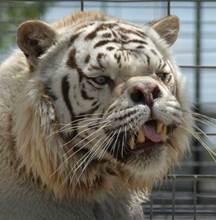
After a few generations of in-breeding have been practiced, what is referred to as a “Type” will start to emerge from the now tightened population that express greater genetic purity? What is being created is the preference between men and what they seek in their Ideal. The high degree of purity that has been created through inbreeding for characteristics and traits like performance and relationship have taken on their own distinction in appearance, a “Type” has been created with-in the Breed.
One that when viewed, not only expresses a sound representation of the Breed Standard, but also shows a family relationship like peas in a pod.
In cases where performance is high on the list as in Tipplers, this also has been capitalized upon through the use of selection and in-breeding.
Dr. Carl Naether from his book Book of the Racing Pigeon wrote,
“ To breed from a type, but from a type of quality, mated with a near relative, likewise of quality: to maintain the quality, the highest level of quality, at each generation and in all generations: to select stringently according to the principals laid down, such, I think, are the observations which most nearly approach what a pigeon fancier should know and put into practice to obtain results in the breeding of a strain “
In the case of pigeons of distinct Breed, “Type” really speaks to the bird’s conformation as it is the most visible of the standard in witch it falls. In some cases and in some individuals it serves as a “trademark” of recognition with-in the general population, and acts as even greater evidence of its ability to conform to the Breed Ideal. In short, when one can be labeled of sound Type, it is additional evidence of purity of breeding above that of the average specimen.

All true breeders are always on the lookout for that exception Sire or for that matter a Dam. One that has shown its ability to pass on its great genetics to its offspring. Prepotency is the term of distinction if one can carry that flag. Its superior genetic purity expresses its dominance and homozygosis, and in some cases its ancestral linkage of heredity.
The most common cause of difference in prepotency is simply the degree of homozygosis between the stocks in question. In a perfect world, and a perfect homozygous individual could only produce such a gamete. Its entire offspring would receive all the same genes form it and the only difference in its genetic make-up would come from the other parent. As mentioned earlier, Dominance is the other degree of importance that makes up Prepotency. If the genes that are passed on to the offspring are dominate in themselves, then the offspring will show, and appear exactly alike for that effect of that gene, regardless of the gene base they had received from the other parent.
Speaking of prepotency, with-in a Sire, I have had the pleasure of knowing such a Stud. Anyone that should have the great success of breeding such an animal should hold him in very high regard as they do not came along every day. In fact it could take a lifetime of breeding and never really obtain a truly great Sire. One such breeder that has been doing it for over forty years ( seems like a lifetime ) did have that great fortune to breed such a Sire and that fancier is Oskar Zovic, a pigeon fancier and friend to myself and many others. Oskar , being the great man of exceptional sense when it comes to the pigeon hobby recognized his good fortune early and by doing so was capable of utilizing this stud over many a generation and the stud would cover many a great hen, producing many other great Tipplers that carried a high degree of Genetic Purity.
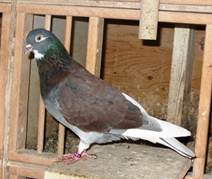
His name “Pecoso” his offspring went on and continues to raise the bar of excellence in many a fortunate loft around the country. His passing was a great loss, but his get will live on for many years to come.
Pecoso is just one example of the power of correct in-breeding/line-breeding.
One other noted form of breeding that exists is termed Outcrossing. It speaks to the fact when certain Strains are crossed with animals that have little genetic relationship, or within a population of mere average worth.
When a highly in-bred specimen is mated to a bird of outside unknown genetic relationship, the offspring have become genetic mongrels, a term I have used many times, in many articles. Mendel’s “Law of Inheritance” would be realized and their new assortment of genes from both parents, weather Dominate or Recessive would largely be of heterozygous in nature, and therefore their breeding “Predictability” of traits and characteristics would be questionable in their offspring. What has taken place is the “dilution of purity” with-in the genes and gene pairs governing these important traits and characteristics you have strived for through the close breeding of relatives.
In short, the concept that governs line-breeding/inbreeding for greater purity would be jeopardized with the introduction of an outcross. Not only in their predictability of all that has been selected for be compromised, but also their ability as breeders in terms of probability’s in future offspring.
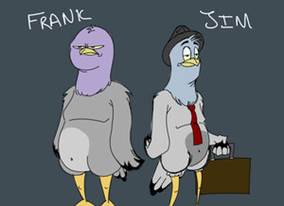
In closing I would like to say that I have tried to make this an interesting read of fact and theory. Animal breeding in itself brings forth many opportunities of witch can prove to be endless in the interest of man. The genetic material made available for those that wish to achieve further excellence are their to be had. Ones “Ideal” can be sought after. When the great animal breeders speak of their particular “Ideal” they also know it has never been realized. Some say those that write these standards of perfection, set the bar so high and seemingly unattainable for one reason and one reason only, and that is to keep the artist in all of us searching for even greater excellence.
Have a great breeding season.
